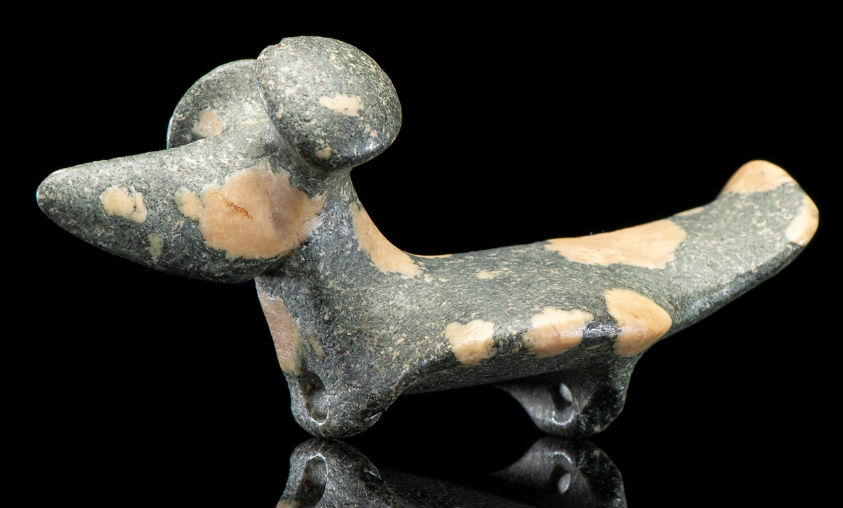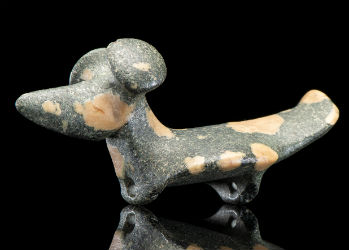
What you see: A porphyry popeye fantail birdstone, created by the people of the Glacial Kame Culture sometime between 3,000 and 500 B.C. what is now DeKalb County, Indiana. Cowan’s Auctions estimates it at $250,000 to $350,000.
The expert: Erin Rust, specialist in the department of American Indian Art at Cowan’s.
What is a birdstone, and what do we know about how the Glacial Kame Culture people might have used it? It’s an effigy, usually carved from a softer stone, and it’s kind of unclear what, exactly, the artifacts were used for. They’re usually field finds. This was found in a potato field in northern Indiana. It was possibly an atlatl [pronounced at-el-at-el] weight–a throwing device used to achieve a higher power when throwing.
Kind of like a counterweight on a trebuchet? It’s an extension of the arm throwing a spear. Harder and faster and for high-powered hunting. We don’t really find them in archeological contexts. It’s up for conjecture what they were actually used for.
How were birdstones made? They were expertly carved, chipped away from a larger block of stone. They roughed out the form in the shape they wanted, then polished it into the final form.
Sounds like a lot of work. Especially if it’s a hard, granite-type stone.
How hard is it to carve porphyry? It’s pretty difficult. It’s a hard, hard stone. They’d typically use banded slate, which is a lot easier to carve. There are not as many porphyry birdstones. They’re much more labor-intensive, and much more rare. About 10 percent of the known birdstones are carved out of porphyry.
Would the cream-colored splotches have drawn the carver to the stone, and influenced how they carved it, in the way that jade carvers in China work with rust-colored inclusions in the stone? Exactly. They would look at the material and decide to carve it based on the cream-colored splotches, which are called phenocrysts.
And why is it called a birdstone? This one, to me, looks more like a dog than a bird. It could be a dog, it could be a bird, but it’s commonly called a birdstone. Some look like bears, some look like birds, some look like dogs. It’s the interpretation of the viewer. “Birdstone” is the general term for it.
And the things protruding from the head are called eyes? I thought they were ears. They’re called eyes, but whether they’re actually ears or eyes is open to interpretation as well.
Is it made to be held in the hand? It is small, but because of the perforations on the ridges at the bottom, it [was probably] meant to be attached to something like an atlatl rather than held.
To be clear, if birdstones were found in an archeological context, they’d be more likely to be considered jewelry. Because they’re found in fields, it’s more likely they were attached to an atlatl with a sinew and maybe the sinew broke. It could be jewelry, but they’re found in fields. We don’t really find them in an archeological context.
Cameron Parks, who owned this piece, deemed it the finest birdstone in the world. Is it? What makes it so? This piece is regarded as one of the top five examples of popeye porphyry birdstones. What makes it unique is the blue hue to the stone. Porphyry can be quite dark. The blue hue with the cream phenocrysts makes it pop and makes it unique. Also, the pop eyes are large on the top of his head, and the form tapers into his head. And the bodies are usually long and slender, but with this, the body expands into a circular form, and a tail that widens to a fantail, and tips up.
This birdstone was found in 1950. Was the mid-20th century a time when many birdstones were being discovered? Among the top five greatest birdstones, this piece was discovered the latest. The Smithsonian birdstone was discovered in 1882. The majority of them had been discovered by 1950.
What condition is it in, and what does “condition” mean when we’re talking about something that’s thousands of years old? As old as this piece is, it’s in exceptional condition. With these, the head breaks off, the tail breaks off, the eyes or ears break off. On this, nothing has broken off. It has two small nicks, one on the bottom near a perforated ridge, and one on the top edge of the left eye. The fact that it’s never broken and it’s as old as it is is pretty amazing.
The lot notes say it retains its original polish. What does that mean here? This piece did not spend time buried in acidic soil. It has not deteriorated. The polish is the same as it was when it went in the ground. The surface is very smooth. There’s no pitting to it. It’s incredible.
So, it being made of porphyry made it more resilient? Birdstones made from banded slate lose their polish faster and the ground erodes them quicker. Porphyry ones are less likely to erode.
Has this piece been auctioned before? It’s been in the same family for 70 years. They have offered it before at auction, probably eight years ago.
What does the Cameron Parks provenance add to the piece? Cameron Parks had one of the largest and better [artifacts] collections in the country. That makes artifacts from his collection are more sought-after.
What’s the record for a birdstone at auction? Very few, if any birdstones of this caliber have been offered at public auction. They have been offered privately, but not at auction. We had a very nice collection of 30 to 35 birdstones, but not of this caliber. We sold them starting in 2017 and finishing in September 2018. That was a very large collection of birdstones, but normally when they come up there are one or two, not 30 to 35.
What is it like in person? He’s small, but he’s pretty mighty. [Laughs] I call him “he.” It has a very strong presence to it. The craftsmanship of it is absolutely incredible. Very few [other birdstones] compare to this piece because of its craftsmanship, the material, everything about it.
What is it like to hold it in your hand? It fits perfectly in your hand, but it doesn’t feel like something [designed] to hold on to. The perforations at the bottom makes it sit oddly in the hand. That’s why it might have been used with an atlatl.
Is there anything that the camera doesn’t pick up? The camera really emphasizes its presence. When you first see it, you think, “Whoa, he’s kinda small.” Then you handle it, and its aura is magnificent. I think the photographer really captured the presence in this piece.
Why will this piece stick in your memory? It’s a rare opportunity to have close access to such a high-level artifact. I probably won’t have the opportunity to see this caliber of birdstone come through the door again. It’s pretty remarkable.
The porphyry popeye fantail birdstone is lot 22 in the American Indian and Western Art: Premier Auction taking place at Cowan’s Auctions in Cincinnati on April 5.
Cowan’s is on Twitter and Instagram.
___
By SHEILA GIBSON STOODLEY
[av_button label=’View the fully illustrated catalog and bid on LiveAuctioneers.’ link=’manually,https://www.liveauctioneers.com/catalog/137745_american-indian-and-western-art-premier-auction/’ link_target=’_blank’ size=’medium’ position=’center’ label_display=” icon_select=’no’ icon=’ue800′ font=’entypo-fontello’ color=’theme-color’ custom_bg=’#444444′ custom_font=’#ffffff’ av_uid=’av-7hseesb’ admin_preview_bg=”]


